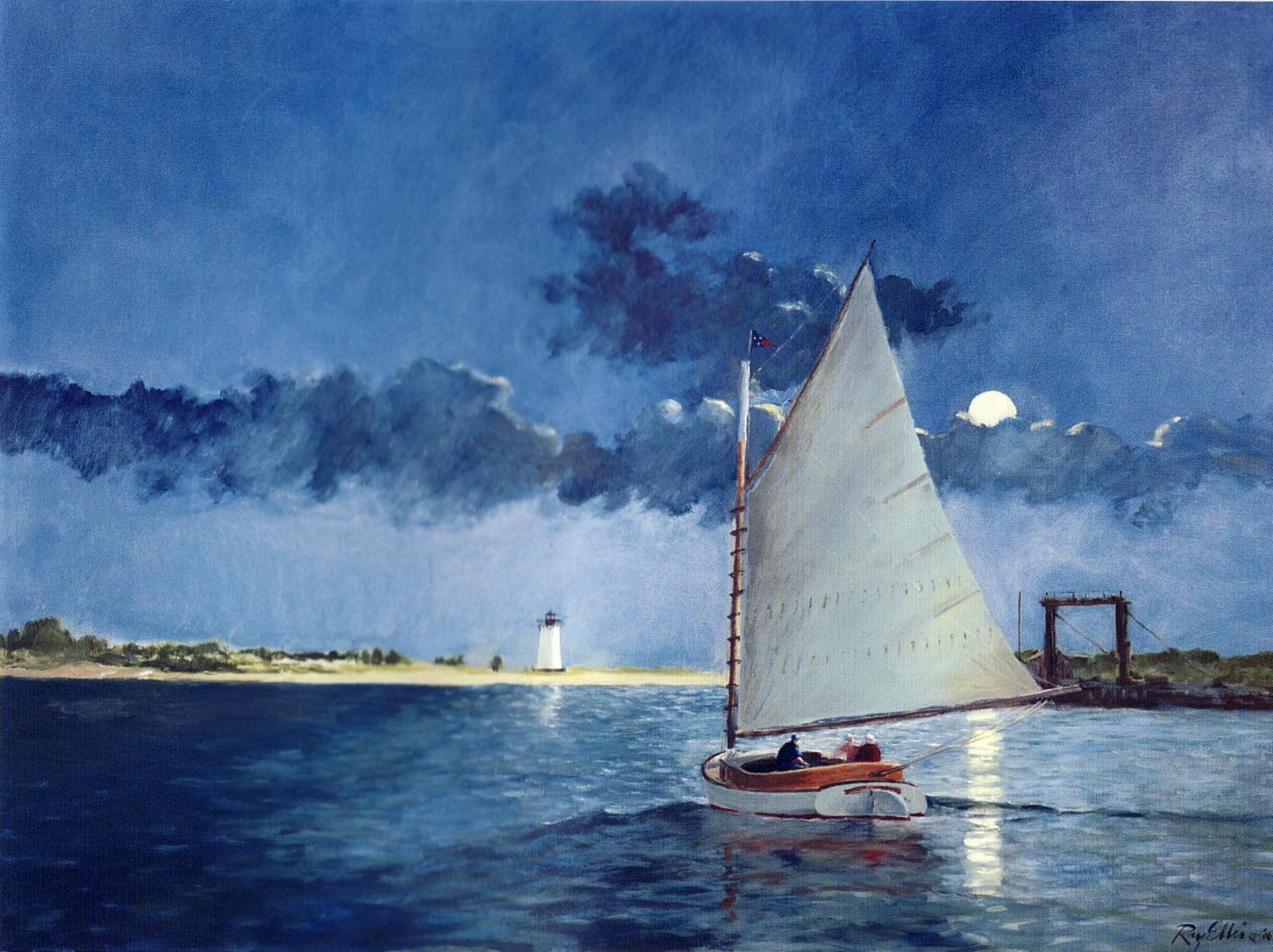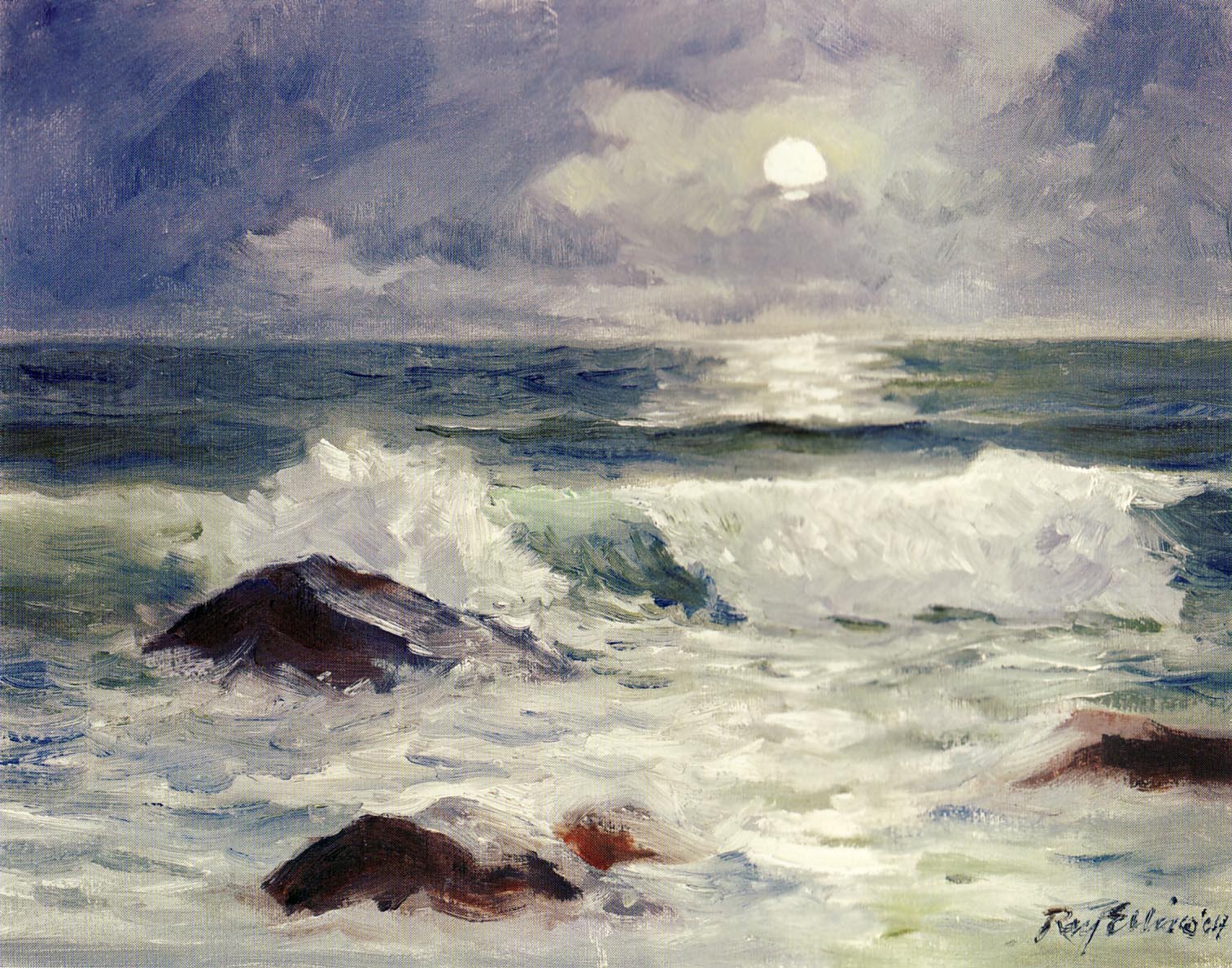Island artist and American Impressionist Ray Ellis launches his 15th book, called By the Light of the Moon: The Moonlight Paintings of Ray Ellis, with a talk tonight at 7:30 p.m. at the Bunch of Grapes Bookstore on Main street in Vineyard Haven. Art historian Valerie Ann Leeds, adjunct curator of American art at the Flint Institute of Arts, traces the artist’s development as a painter of the night in this edited version of the introductory essay.
The evocative and poetic possibilities of moonlight subjects have long captivated the imagination of poets, composers and artists. Artists have been inspired by distinctive atmospheric conditions, but relatively few have explored night scenes, which pose an artistic challenge — a challenge compounded by the changing aspects of the moon and its emanating and reflected light. Silvery and cool, moonlight lends the only natural visibility in the night’s shroud of darkness.
Ray Ellis, a painter known for regional landscapes, notably of the southern lowcountry and of Martha’s Vineyard, has been consistently drawn to moonlight and twilight subjects since the 1980s. His acquaintance with the alluring moonlight paintings of American artists such as Winslow Homer, Frederick Judd Waugh, James McNeill Whistler, Ralph Blakelock, Albert Pinkham Ryder and Elliot Daingerfield, as well as the Tonalists, resonated with him. It was particularly the night scenes by painters of the American West, notably those of Donald Teague and Frank Tenney Johnson, that prompted him to attempt moonlight scenes of his own.
Since the 1980s, moonlight themes have grown in importance in Ellis’s oeuvre. They have become among his most sought-after works.
There is an unusual degree of variety in Ellis’s moonlight compositions. Painted where he lived, his works incorporate lighthouses, dunes, fishing boats (with oystermen, shrimpers and seiners), harbors, rivers, open seas, sailboats and urban settings. In his moonlight paintings, the moon is represented in all its phases with varied atmospheric effects, often with reflections on the water, at all times of the day and night, from dawn to darkest night.
Through years of investigation, Ellis found that these silvery moonlight scenes demanded a palette of predominantly cool colors. He abstains from the use of red, instead concentrating on colors within the families of yellow ochre and sap green and also includes white, cobalt, cerulean blue, burnt umber and burnt sienna. He starts painting at the top of canvases with cobalt and umber, and as he progresses toward the horizon he uses brighter cerulean blue. To represent a moon high in the sky, he often uses true white mixed with a touch of blue, but this varies depending on the time of year and the type of moon. A harvest moon, for example, appears golden tinged with orange. Ellis compares realizing the proper palette to making a “stew, adding a little of this and a little of that, until the proper mix can be achieved.”
His approach to painting night and moonlight scenes has evolved over the years. Initially, he painted directly from the subject, but having painted moon and night subjects over a long period of time, he is now able to see a composition in his “mind’s eye” and largely works from his imagination.
In 1972 Ellis visited Martha’s Vineyard and became enthralled with the region. He found the area’s differences from the southern coastal lowcountry as compelling as its similarities. He moved to the Island full time in 1991. While the general themes of Ellis’s paintings did not radically alter with the change in residence, the light, climate, and topography of the region subtly affected his paintings. Among the most articulated differences are the moonlit dunes, lighthouses and bluffs of the northeastern coast, which he substituted for the marshes, old oak trees, and hanging moss that are characteristic of his southern views.
Mr. Ellis has now become closely identified as well with typical Vineyard themes of harbors, lighthouses and sailboats. The northern atmosphere is evident in the harbor and coastal waters enveloped by dark sky in Edgartown Harbor — Full Moon (2003) Moonlight Walk (2003), and Chappy Moon (2002). The deep rich tonalities of these works mirror Ellis’s growing confidence in his ability to create convincing portrayals of the effects of moonlight and night skies. He has also pictured moonlight reflecting off low-lying clouds — an even more difficult feat. These Vineyard scenes often include the signature stocky white form of the Edgartown lighthouse, seen in Moon Over Chappy (2001) and the harbor view Moonlight Edgartown (2004).
Ellis has been consistently attracted to sailing since his stint in the Coast Guard from 1942 to 1945, when he first began painting marine scenes at sea. He often places majestic sailboats as the focal point in compositions, which become increasingly romanticized in moonlight scenes.
Ellis holds Winslow Homer’s works in high esteem, particularly his sailing and boating subjects. Homer, however, preferred more tumultuous marine scenes, [including] depicting fishermen caught in stormy weather. In a departure, his watercolor Eastern Point Light (1880) shows a becalmed atmosphere and a vast body of water that alludes to a world beyond. Ellis pays homage to this deceivingly simplified composition in his own watercolors, Tide Line (2006), Moonlight Returns (1995), and Moonlight Off Tybee Light (2006), which capture a similar mood.
One of the most romantic associations with the moon is the fleeting beauty of the moonlight on the surf and open sea. In differing grades of light, Ellis reinterprets this universal scene of the nighttime sky, surf, and sea beyond in its endless variations. Inspired by the paradigm established by such marine painters as Frederick Judd Waugh, whose reputation rests solely on his dedication to the theme of the open sea, Ellis too became captivated by the ever-changing seascape in his work.
Ellis’s most evocative moonlight scenes are those that exploit the drama of strong contrasts, particularly in winter moonlit scenes in which the whiteness of the moon and snowy landscape is juxtaposed against the darkness of a midnight sky. These counterpoints of landscape and moody atmosphere... project a pointedly stark and haunting beauty.
Looking up at the night sky, at the sheer beauty of an exceptional moon, from crescent to full, evokes awe in the viewer. Many possible experiences resonate on these occasions, giving rise to emotion and introspection. Much symbolism and many varied mythologies are associated with the moon, such as the feminine side, spirituality, melancholy, mystery; psychic phenomena, insanity and romance. For Ellis, however, romance and nostalgia surpass other interpretations. His moonlit scenes are generalized and universal. Eliminating modern day details Ellis’s moonlight paintings suggest a bygone era that evokes the romance and nostalgia of a simpler time.





Comments
Comment policy »